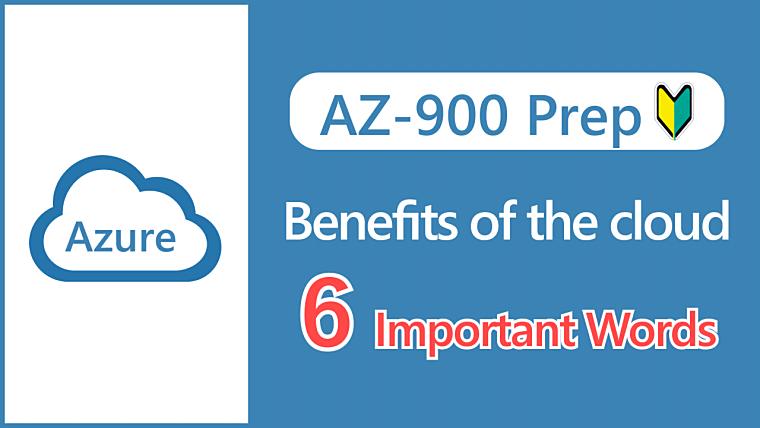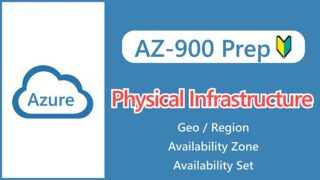Hi, I’m Makoto, a freelance engineer.
In this article, I’ll explain some terms that describe the benefits of the cloud.
In that article, I explained the five characteristics of the cloud and their benefits, with diagrams.

That article mainly focused on the benefits of using cloud computing from the time you procure a server to the time you complete the construction, but this time we will focus on the benefits of using a server once it has been constructed.
In the AZ-900 exam, words often appear that describe characteristics such as being resistant to obstacles and disasters, being able to withstand stress, and being able to respond to change, and you are asked about the significance of these as benefits of the cloud.
There are also terms that have similar meanings but slightly different nuances, so please read this article to deepen your understanding. Let’s get started!
High Availability
Availability is the degree or ability of a system or service to be continuously available.
The ability to use a system or service at any time is called “high availability”.
The ability to use a system or service continuously.
Azure provides a variety of mechanisms to ensure high availability. For example, by deploying multiple servers and backing them up across regions and datacenters, you can build a system that is resilient to disasters and local failures.
Note that higher availability tends to be more expensive, so there is a trade-off with cost.
Fault Tolerance
Fault tolerance is the ability of a system to continue normal operation in the event of a failure of one part of the system.
Even if there is a failure in one part of the system, it can continue to provide services normally.
For example, even if there is a power outage, the system can switch to a private power generator to continue providing power. Even if a disk that stores data fails, the data will not be lost because it will be written to another disk.
It means almost the same as high availability. Remember it as a set with high availability.
Disaster Recovery
Disaster Recovery (DR) refers to the processes and strategies used to quickly restore business operations following a major disruptive event, such as a natural disaster.
The ability to recover quickly from large-scale disasters, such as natural disasters.
Azure has the ability to duplicate and replicate servers across regions and datacenters, so if, for example, the entire Japan East datacenter goes down, a system can be set up to recover using the Japan West datacenter.
As a similar term, the aforementioned fault tolerance refers to the property of “not stopping service even if part of it stops”, while disaster recovery is an effort to “recover quickly even if service stops” (in most cases, the goal is to recover as quickly as possible while allowing for some downtime).
Scalability
Scalability is the ability to increase or decrease the number of servers at will (especially to increase the number of units or improve performance).
The ability to freely increase or decrease the number of servers and increase or decrease performance.
Adjusting the number of servers or their performance is referred to as “scaling,” a common concept when learning about cloud computing. It’s important to remember the following terms together:
- Scaling out: Increasing the number of servers
- Scaling in: Decreasing the number of servers
- Scaling up: Increasing the performance
- Scaling down: Decreasing the performance
- Auto scaling: Automatically adjusting the number of servers based on the load
Elasticity
Elasticity is the ability to automatically adjust to load. In short, it is the ability to scale automatically.
The ability to adjust automatically in response to load.
A term with a similar meaning is scalability, but scalability has a stronger meaning of “manually” scaling in a planned way, such as with the size of a service, and has a slightly different purpose than elasticity, which “automatically” scales with load.
Agility
Agility is the ability to respond quickly to change.
The ability to respond quickly to change.
The ability to deploy quickly when application requirements change or features are added, and the ability to spin up and tear down servers quickly, allows the development cycle to move much faster than before.
A similar term is “agile”, and you may have heard the term agile development. Agile development is a method of rapid development in small functional cycles.
Summary
In this article, we have explained six important terms that describe the benefits of cloud computing. The terms can be summarized as follows:
| Term | Meaning |
|---|---|
| High Availability | The ability to use a system or service continuously |
| Fault Tolerance | Even if there is a failure in one part of the system, it can continue to provide services normally |
| Disaster Recovery (DR) | The ability to recover quickly from large-scale disasters, such as natural disasters |
| Scalability | The ability to freely increase or decrease the number of servers and increase or decrease performance |
| Elasticity | The ability to adjust automatically in response to load |
| Agility | The ability to respond quickly to change |
There are also similar terms that can be confusing, but are also important for understanding Azure’s core services and features. Make sure you remember them.












